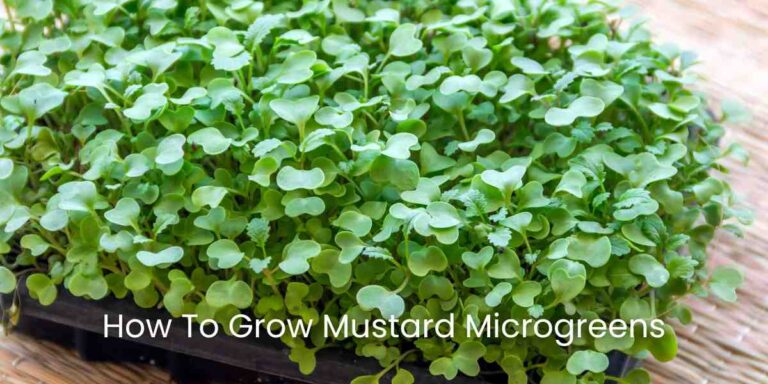Want to Learn Growing Microgreens Without Grow Lights?: Natural Method
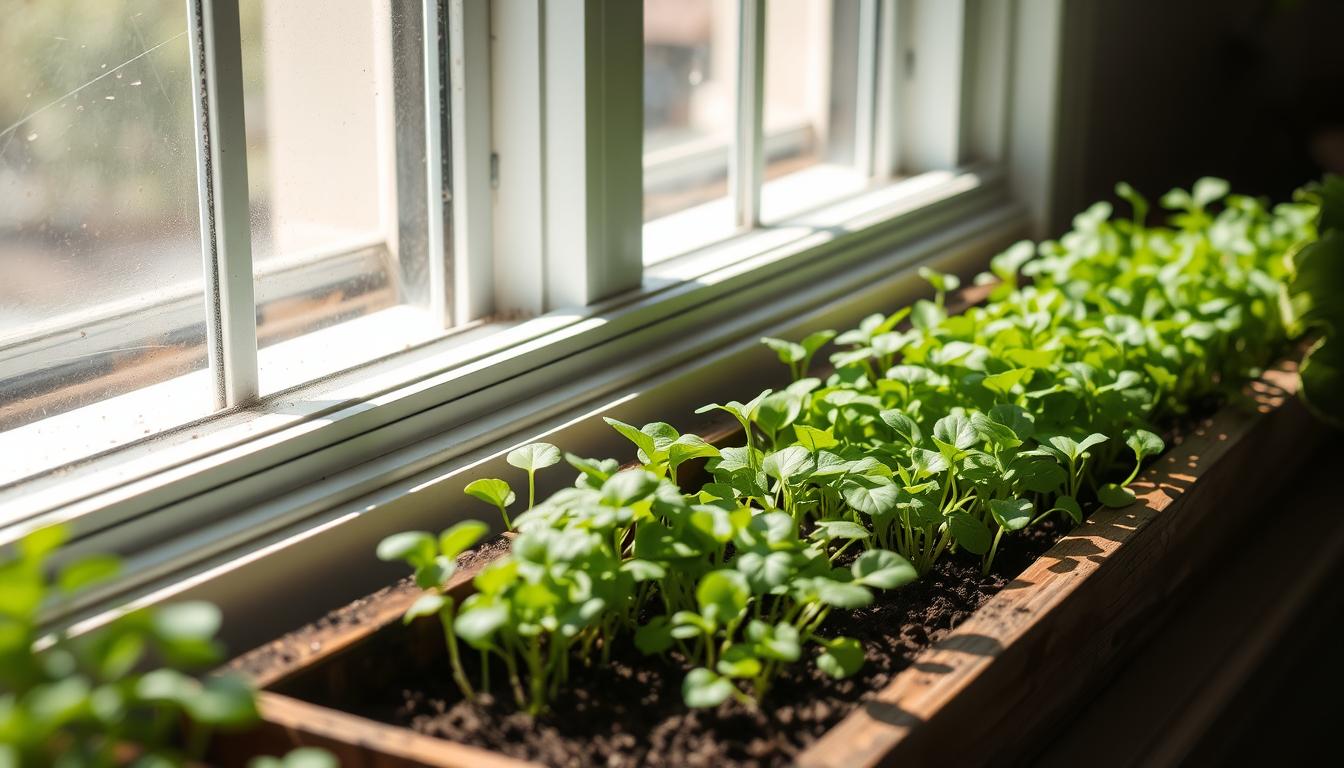
Did you know microgreens have up to 40 times more nutrients than full-grown greens? This fact has made them a big deal in sustainable food. If you want to learn growing microgreens without grow lights, you’re in for a treat. Natural microgreen farming is easy and very rewarding.
Imagine getting fresh, nutrient-rich greens from your windowsill in just two weeks. Sunlight microgreens are great for city folks and health buffs. With little space and basic tools, you can start a sustainable microgreen growing journey that fits with nature’s beat.
This method is simple and beautiful. Using natural light, you’re not just growing food; you’re going green. Whether you’re an experienced gardener or new to it, growing these tiny greens is fun and calming.
Key Takeaways
- Natural light is enough for growing healthy microgreens at home.
- Windowsills and kitchen counters are perfect for sunlight microgreen growing.
- Growing microgreens naturally is a calming and fulfilling hobby.
- Sustainable microgreen growing needs little space and basic tools.
- Natural microgreen farming is good for the planet and gardening.
Introduction
Growing microgreens indoors without special lights can be a fun challenge. It’s a great way to grow healthy greens at home. This method is easy and good for the planet.
The Challenge of Natural Light Cultivation
Microgreens need lots of light to grow well. But, you can use natural light to help them grow. It’s all about using the right techniques.
Natural Light: An Effective Alternative
Natural sunlight is perfect for growing microgreens. It gives them the light they need for photosynthesis. This makes them strong and healthy.
Studies show that microgreens grown in sunlight are very nutritious:
- They have five times more vitamins and carotenoids than big plants.
- Some types have up to 40 times more nutrients than big veggies.
- Red cabbage, cilantro, and amaranth microgreens are full of vitamins C, K, and E.
Key Factors for Successful Cultivation
To grow microgreens well in sunlight, pay attention to a few things:
| Factor | Importance | Considerations |
|---|---|---|
| Light Intensity | Critical | Choose a bright spot, like a south-facing window |
| Temperature | Moderate | Keep it between 18-24°C for most types |
| Humidity | Low to Moderate | Make sure air moves well to stop mould |
| Growing Medium | Important | Use soil that drains well or something like coconut coir |
| Watering | Crucial | Keep the soil moist but not too wet |
With these tips, you can grow microgreens in 10-14 days for fast ones, or up to 25 days for slower ones. This way of growing saves energy and connects you with nature.

Choosing the Right Location for Natural Light
Growing natural light microgreens needs careful thought about your indoor spaces. The right spot is key to growing healthy, vibrant microgreens for your urban farm.
Best Indoor Spots for Abundant Natural Light
South-facing windows are best for microgreens, getting lots of sunlight. East and west windows offer morning and afternoon light. North windows are less good but can work for some types.
Window Orientation and Light Intensity
Light changes with window direction. South windows get up to 400 µmol/m²/s, great for most microgreens. East and west windows have 200-300 µmol/m²/s, good for less light needs.
| Window Orientation | Light Intensity (µmol/m²/s) | Suitable Microgreens |
|---|---|---|
| South | 300-400 | Broccoli, Radish, Sunflower |
| East/West | 200-300 | Peas, Basil, Kale |
| North | 100-200 | Lettuce, Spinach, Chard |
Optimal Placement for Different Varieties
Put light-loving microgreens like broccoli in south windows. Herbs like basil do well in east or west. Leafy greens like lettuce can handle less light in north.

Assessing Natural Light Conditions
Use a light meter or watch sun patterns to check light. Aim for 12-16 hours of light a day. If it’s not enough, add grow lights for strong growth.
“The right light makes microgreens mighty.”
Selecting Microgreen Varieties Best Suited for Low Light
Choosing the right microgreen varieties is key for growing in low light. Some types do well in little light, perfect for windowsills or indoor spots without grow lights.
Top Microgreen Varieties for Limited Light
Many microgreen varieties grow well in low light, making them great for indoor gardens. Here are some top picks:
- Rocket: Seeds germinate at room temperature and grow faster in cooler weather
- Radish: Can be sown year-round and grow well at room temperature
- Broccoli: Ready for harvest in 8 to 10 days
- Beetroot: Harvestable in 18-20 days after sowing
- Parsley: High germination rate
- Garden cress: Starts germinating in 3-4 days
Light Requirements for Different Microgreen Types
Knowing what light each plant needs is vital. Plants soak up more blue and red light than green. The Photosynthetic Active Radiation (PAR) they use is between 400 to 700 nanometers.

Recommended Varieties for Windowsill Gardens
For windowsills or low-light spots, try these nutrient-rich microgreens:
- Kale
- Peas
- Arugula
- Mustard
- Chard
- Cabbage
These varieties do well in less light, making them perfect for indoor growing without grow lights.
Characteristics of Light-Tolerant Microgreen Seeds
Light-tolerant microgreen seeds often have these qualities:
- Quick germination
- Rapid growth
- Ability to thrive in cooler temperatures
- High nutrient density
Microgreens can have up to 40 times more nutrients than full-grown veggies. They’re a great pick for health-focused gardeners who grow in low light.
Maximising Natural Light Effectiveness
Growing microgreens without artificial lighting is rewarding. Clever sunlight hacks can make the most of natural light for your indoor garden. Let’s look at some effective ways to grow microgreens using nature’s light.
Capturing Maximum Sunlight
Place your microgreen trays near windows with lots of sunlight. South-facing windows are best in the Northern Hemisphere, giving steady light all day.
Enhancing Light Exposure
Use reflective surfaces to increase light for your microgreens. White walls or light backgrounds can help a lot. Try this trick: cover a cardboard box with aluminium foil and put it behind your trays for a mini reflector.
Ensuring Even Distribution
Rotate your trays every day to ensure even light. This stops your microgreens from growing unevenly towards the light.
Timing Your Planting
Plant your microgreens when the light is best. Start in early spring or late summer for more light and longer days. This leads to healthier, greener crops.
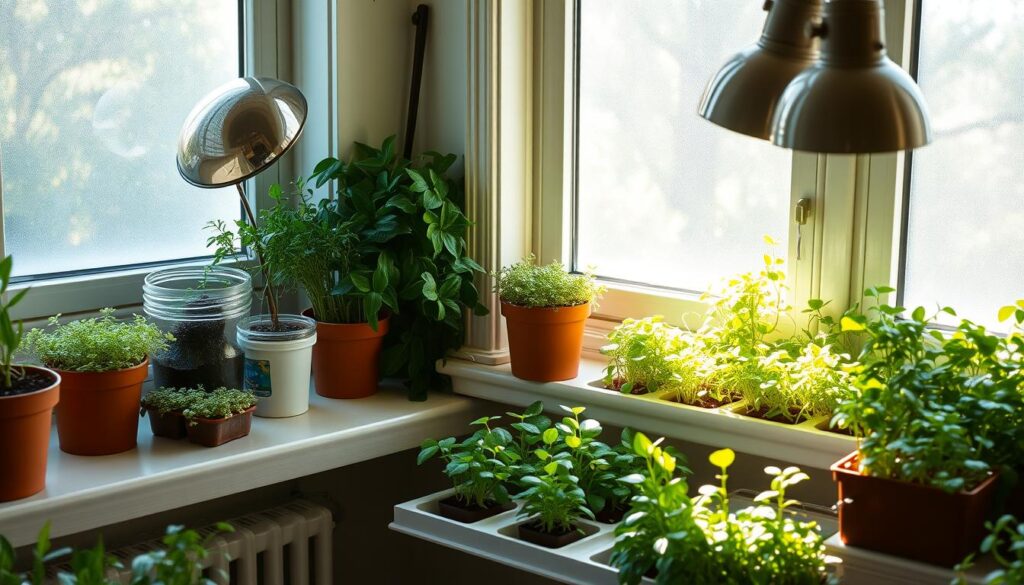
| Light Intensity (µmol/m²/s) | Microgreen Variety | Growth Rate |
|---|---|---|
| 50-100 | Spinach, Kale | Moderate |
| 100-150 | Lettuce, Basil | Good |
| 150-200 | Sunflower, Radish | Excellent |
By using these sunlight hacks, you can grow great microgreens without artificial light. Remember, growing microgreens takes patience and observation. With time, you’ll get better at growing lush microgreens just with natural light.
Alternative Light Strategies
In low-tech microgreen gardening, using light wisely is key. When sunlight is limited, smart methods can help your microgreens grow well.
Harnessing Ambient Light
Put your microgreen trays in bright spots at home. Areas with big windows or skylights work best. Microgreens need six hours of good light each day to grow well.
Maximising Light Reflection
Get more light by placing trays near white walls or using light-coloured backgrounds. This simple trick can really help your microgreen garden.

DIY Light Enhancement
Try these easy, cheap ways to brighten your microgreens:
- Line containers with aluminium foil
- Use small mirrors to redirect light
- Paint nearby surfaces white for better reflection
These tips can help you grow successful microgreens, even with poor light.
Troubleshooting Low Light Challenges
Growing microgreens without grow lights can be tricky. Knowing how to spot and solve common issues is key. Let’s explore ways to overcome low light challenges in microgreen cultivation sunlight and ensure you’re sprouting nutritious greens successfully.
Recognising Insufficient Light
When microgreens don’t get enough light, they often become leggy with pale leaves. This weak growth is a clear sign your plants are struggling. Keep an eye out for these symptoms to catch light issues early.
Precise Growing Techniques
To compensate for reduced light, focus on perfecting other aspects of care. Maintain optimal moisture levels and ensure proper nutrient balance. These steps can help your microgreens thrive even in less-than-ideal lighting conditions.
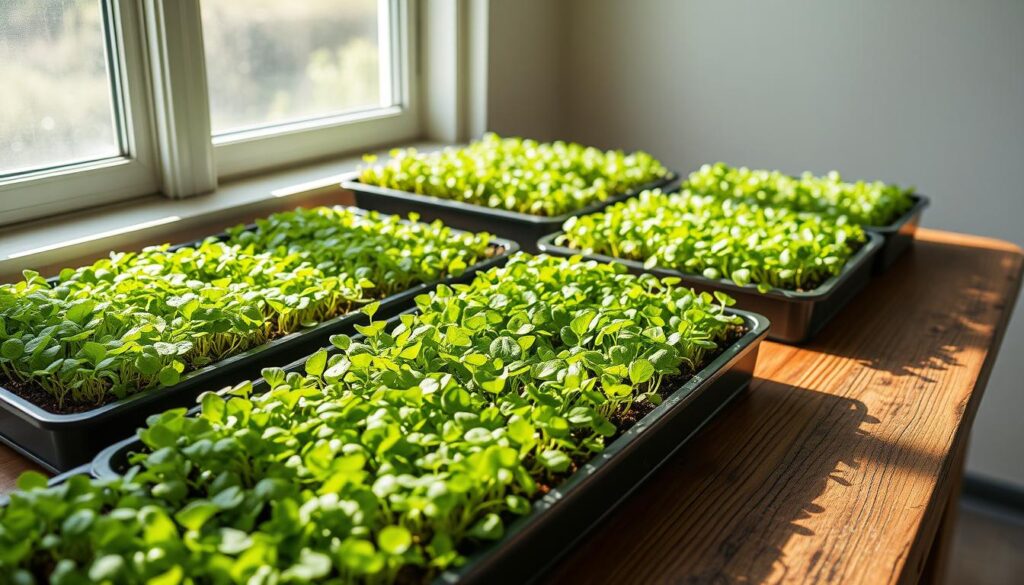
Adjusting for Low-Light Conditions
In low-light environments, adjust your watering frequency and growing medium. Water less often to prevent mould growth, which is more likely in dimmer conditions. Use a well-draining medium to further reduce moisture-related issues.
Preventing Weak Growth
To avoid leggy microgreens, ensure adequate spacing between seeds and rotate trays regularly. This promotes even light distribution and stronger growth. Consider using a mesh tray for tamping down growing media evenly, which can help with uniform growth.
| Common Issue | Cause | Solution |
|---|---|---|
| Uneven seeding | Uneven planting surface | Use a mesh tray for even media distribution |
| Low germination rate | Poor seed quality | Use seeds with at least 75% germination rate |
| Mould growth | Lack of airflow, excess humidity | Improve ventilation, reduce watering |
| Slow growth | Insufficient light after germination | Increase light exposure or duration |
By addressing these common challenges, you can significantly improve your success in sprouting nutritious greens, even in low-light conditions. Remember, patience and careful observation are your best tools in microgreen cultivation.
Optimal Growing Conditions Beyond Light
Successful soil-based microgreen production is more than just light. Let’s look at key factors for growing pesticide-free microgreens without artificial lighting.
Temperature Management
For the best microgreen growth, keep temperatures between 15-24°C. This helps with germination and growth. If it’s cold, place trays near radiators or use heat mats to warm the soil.
Humidity Control
Microgreens love humid environments. Use clear lids or a small humidifier to keep moisture up. Mist twice a day to keep them hydrated but not too wet.
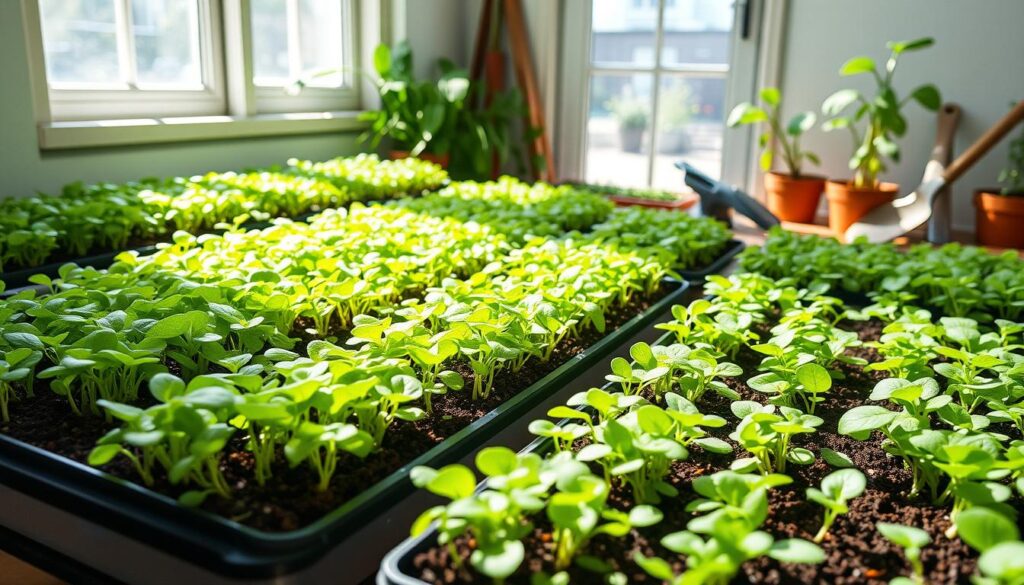
Choosing the Right Growing Medium
Pick a medium that holds moisture but also drains well. Peat-based mixes or coconut coir are good for soil-based microgreens. They help with root growth and nutrient uptake, essential for pesticide-free microgreens.
Watering Strategies
Watering right is key for healthy growth without grow lights. Bottom watering prevents wet leaves and lowers disease risk. Start with 1-2 cm of water and let the medium soak it up. This method promotes strong roots and even hydration.
| Factor | Recommendation |
|---|---|
| Temperature | 15-24°C |
| Misting Frequency | Twice daily |
| Growing Medium | Peat-based or coconut coir |
| Watering Method | Bottom watering |
Optimising these conditions helps grow nutrient-rich, pesticide-free microgreens with natural light. Remember, regular care and attention to these factors will give you the best results in your soil-based microgreen production.
Step-by-Step Growing Process
Growing microgreens without grow lights is rewarding for DIY fans. This guide will show you how to grow microgreens using sunlight. It’s perfect for those who love natural gardening.
Choosing and Preparing Growing Trays
Choose shallow trays with holes for drainage. Soak the growing medium in water or a nutrient solution. Use coconut coir or fibre mats for soil-less growing in sunlight.
Sowing Techniques for Low-Light Environments
Spread seeds evenly when sowing. In low light, seed density is key. Some seeds need soaking to germinate well. The best temperature for growth is 15-24°C.

Daily Care and Monitoring
Microgreens need 6-8 hours of light daily. Mist seeds until they sprout. Water at the roots once stems grow. Some, like peas, prefer pooled water, while others, like amaranth, need light watering. Keep humidity at 40-60% for best growth.
Harvesting Tips for Microgreens Grown in Natural Light
Harvest microgreens when they’re 5-14 days old. Soil-less methods grow faster, ready in 7-12 days. Cut just above the soil and store in a sealed container for up to a week.
| Growing Method | Time to Harvest | Light Requirement |
|---|---|---|
| Soil-based | 1-4 weeks | 6-8 hours daily |
| Soil-less (Hydroponics/Mats) | 5-12 days | 6-8 hours daily |
Follow these steps to grow nutrient-rich microgreens with sunlight. This method is sustainable and allows year-round growing, like growing basil indoors. Enjoy harvesting your own fresh microgreens!
Common Mistakes to Avoid
Growing microgreens without grow lights can be rewarding for urban farming fans. But, there are common mistakes to avoid. Let’s look at two key ones and how to steer clear of them.
Overwatering in Low-Light Conditions
One big challenge is keeping the right moisture levels with natural light. Too much water can cause mould and root rot, more so in low light. To avoid this, use a two-tier tray system and water from the bottom. This method spreads moisture evenly without harming the seedlings.
Incorrect Seed Density
Another key factor is the right seed density. Too many seeds can lead to weak plants and disease. Make sure to sow seeds evenly and follow spacing guidelines. This helps plants grow strong and healthy, without fighting for light and nutrients.
| Mistake | Consequence | Solution |
|---|---|---|
| Overwatering | Mould growth, root rot | Use bottom watering technique |
| Overcrowding | Weak growth, disease risk | Follow proper seed spacing |
| Poor light management | Leggy plants, slow growth | Rotate trays, use reflective surfaces |
Avoiding these mistakes will help you master urban microgreen farming with natural light. Successful growing needs attention to detail and a willingness to learn. With practice, you’ll enjoy fresh, homegrown microgreens all year.
Conclusion
Growing microgreens without artificial lighting is easy and rewarding for home gardeners in India. You can use natural light for sustainable microgreen growing. This method is good for the environment and saves money.
Key Strategies Recap
To succeed in natural microgreen farming, pick the right spot and choose the best varieties. Also, make the most of the light you have. Indoor microgreens need about 60% of the sunlight outdoor plants do. This is great for city folks with little outdoor space.
Experimentation Encouragement
We urge you to try out different microgreen types and methods. Use coco coir or peat moss as your growing medium. Keep the temperature between 18-24°C (64-75°F) for the best growth. Remember, every crop is a chance to learn and improve in sustainable microgreen growing.
Sustainability and Accessibility
Natural light microgreen growing is a simple way to get nutritious greens at home. It’s flexible, letting you move your trays for the best light. By using less artificial light, you help the planet and enjoy fresh, homegrown food. Begin your natural microgreen farming today and see the difference!



